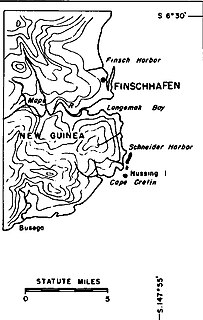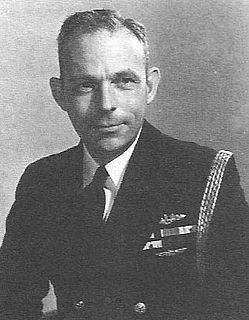This article includes a list of references, related reading or external links, but its sources remain unclear because it lacks inline citations .(November 2021) |
Morobe Bay is a bay within Huon Gulf, on the coast of Morobe Province, Papua New Guinea.
This article includes a list of references, related reading or external links, but its sources remain unclear because it lacks inline citations .(November 2021) |
Morobe Bay is a bay within Huon Gulf, on the coast of Morobe Province, Papua New Guinea.
The American and Australian armed forces used Morobe Bay, also known as "Morobe Harbour", as a safe anchorage and staging point as part of the New Guinea campaign during World War II.
A PT boat advanced base was relocated from Tufi and set up within Morobe Bay by the US Navy, instead of Douglas Harbour near Cape Ward Hunt on 20 April 1943.
Lae is the capital of Morobe Province and is the second-largest city in Papua New Guinea. It is located near the delta of the Markham River and at the start of the Highlands Highway, which is the main land transport corridor between the Highlands Region and the coast. Lae is the largest cargo port of the country and is the industrial hub of Papua New Guinea. The city is known as the Garden City and home of the University of Technology.

For administrative purposes, Papua New Guinea is divided into administrative divisions called provinces. There are 22 provincial-level divisions, which include 20 provinces, the Autonomous Region of Bougainville, and the National Capital District of Port Moresby.

Morobe Province is a province on the northern coast of Papua New Guinea. The provincial capital and largest city is Lae. The province covers 33,705 km2, with a population of 674,810, and since the division of Southern Highlands Province in May 2012 it is the most populous province. It includes the Huon Peninsula, the Markham River, and delta, and coastal territories along the Huon Gulf. The province has nine administrative districts. At least 101 languages are spoken, including Kâte and Yabem language. English and Tok Pisin are common languages in the urban areas, and in some areas pidgin forms of German are mixed with the native language.

PT-337 was a PT-103-class motor torpedo boat that was sunk in action during the Pacific Theater of World War II in Hansa Bay, New Guinea, on March 7, 1944.

Papua New Guinea is divided into four regions, which are its broadest administrative divisions of Papua New Guinea. While the 22 provincial-level divisions are the primary administrative divisions of PNG, the regions are quite significant in daily life, as they are often the basis for organisation of government services, corporate operations, sporting competitions, and even the machinations of politics.
Morobe may refer to several places in Papua New Guinea:
The Papua New Guinea national rugby union team, nicknamed the Pukpuks,, played its first international in 1966, defeating Vanuatu 47–3. Papua New Guinea have not so far qualified for a Rugby World Cup. They participated in the Oceania World Cup qualifying tournaments for the 2007, 2011 and 2015 World Cups, but did not qualify.
Labu is an Austronesian language of Papua New Guinea.
I-177 was an Imperial Japanese Navy Kaidai-type cruiser submarine of the KD7 subclass commissioned in 1942. She served during World War II, patrolling off Australia, taking part in the New Guinea campaign, operating in the North Pacific, and participating in the Palau campaign before she was sunk by the destroyer escort USS Samuel S. Miles (DE-183) in 1944, with no survivors.

Finschhafen is a town 80 kilometers (50 mi) east of Lae on the Huon Peninsula in Morobe Province of Papua New Guinea. The town is commonly misspelt as Finschafen or Finschaven. During World War II, the town was also referred to as Fitch Haven in the logs of some U.S. Navy men.

The Landing at Nassau Bay was an amphibious landing by Allied forces at Nassau Bay during the New Guinea campaign of World War II that took place between 30 June and 6 July 1943. The operation was undertaken so that Allies could secure a beachhead to establish a supply point to shorten their supply lines for the proposed attack on Salamaua as part of the Salamaua–Lae campaign and resulted in a battalion-sized force of US infantry and supporting elements being landed largely unopposed on the south-eastern flank of the battle zone.

Tufi is a town located on the south eastern peninsula of Cape Nelson, Oro Province, Papua New Guinea. Tufi is located on one of many rias, or drowned river valleys, locally referred to as 'fjords', on Cape Nelson surrounded by many uncharted reefs. The area is also famous for its production of tapa cloth.
Morobe is a small coastal village located in Morobe Bay, in the south of Morobe Province, Papua New Guinea.
Kelanoa Harbour is a harbour on the north coast of the Huon Peninsula in Papua New Guinea serving the town of Kelanoa. It is a large bay with an impenetrable reef and a small island.

Rear Admiral Morton Claire Mumma, Jr. was a senior officer in the United States Navy. He was awarded the Navy Cross for actions on 13 December 1941 while commanding USS Sailfish (SS-192) during World War II. He later served as naval aide to Secretary James Forrestal in 1944–45, and retired in 1946. Mumma was president of the National Rifle Association from 1955 to 1957, and at his death was on the association's executive council.
Kabwum District is a district of the Morobe Province of Papua New Guinea. Its capital is Kabwum. The population of the district was 43,472 at the 2010 census. It is one of the mountainous places in Papua New Guinea. It is made up of four local level governments (LLGs) namely Komba, Selepet, Timbe or Deyamos and Yus. It shares its borders with the following districts of Morobe namely Finchhafen, Nawaeb and Tewai-Siassi. It also shares its border with Raicoast District of Madang Province. There are no direct road link from Lae City, the Provincial Capital to Kabwum District. So the way to get there from Lae is either by small planes or by ship and speed boat. If you choose to arrive by a plane then it will drop you directly at one of the local air-strips in the district. But if you choose ship or speed boats, then they will drop at Wasu where there is a highway road called Kabwum Highway linked to the mountainous part of the District. From there you can choose one of the local PMV to take you to your destiny.
PT-143 was a PT-103-class motor torpedo boat of the United States Navy that served during World War II.

US Naval Advance Bases were built globally by the United States Navy during World War II to support and project U.S. naval operations world-wide. A few were built on allied soil, but most were captured enemy facilities or completely new. Advance bases provided the fleet with support to keep ships tactically available with repair and supply depots of facilities, rather than return them to continental United States. Before Japan declared war on the United States the US Navy had a single fleet sized advanced base in the Territory of Hawaii. It was Naval Station Pearl Harbor. During the war the US Navy Seabees built over 400 advance bases categorized by size. Naval bases were either Lions or Cubs while airfields were either Oaks or Acorns. Lions and Oaks were major facilities while Cubs and Acorns were minor. PT Boats typically would get a Cub and airfields with single runways were Acorns. The larger bases could do refueling and overhaul; loading of troopship and cargo ships; and preparing amphibious assault ships. Some became major repair depots. The Seabees developed auxiliary floating drydocks were able to repair battle damage and do regular maintenance in the field saving ships trans-pacific trips for repair. A few bases also were developed to be R and R for all U.S. personnel. Most Advance Bases were built by the US Navy's Seabees in Naval Construction Battalions (CBs). At the start of the war some civilian contractor were employed in construction. The Seabees in World War II built most of the airfields used by the United States Army Air Forces and United States Marine Corps, as they had the ships and cranes needed to transport the vast amount of equipment needed at the advance bases. The US Army and United States Coast Guard also operated out of many of these facilities. Seabees could build new or repair damaged runways, and with advancements in heavy bomber technology lengthen runways as needed. A few Naval Advance Bases were built for the Korean War and Vietnam War.

Naval Base Milne Bay, also called Naval Advance Base Milne Bay, was new major United States Navy sea and airbase base built on Milne Bay in Milne Bay Province in south-eastern Papua New Guinea. By spring 1943, the build up of the US Navy to support the Pacific War had caused overcrowding at the ports on the east coast of Australia. To help the Seabee departed Naval Base Brisbane on June 19, 1943 to set up a new base in Milne Bay. Naval Base Milne Bay headquarters was at Ladava Navy Base. The Royal Australian Navy already had a small base in Milne Bay: HMAS Ladava. Australians were able to defend and keep Milne Bay in the Battle of Milne Bay in 1942. Naval Base Milne Bay was built during World War II to support the many ships and aircraft fighting and patrolling in the South West Pacific theatre of war. Ladava Navy Base provided a large protective US Navy fleet anchorage at Gahora Bay next to Ladava. At Naval Base Milne Bay Seabee built large Naval facility.

Naval Base Finschhafen was a United States Navy base built during World War II at Finschhafen on the Huon Peninsula in Morobe Province of Papua New Guinea. The US Navy built a PT boat base, Dreger Harbor PT Boat Base, boat repair depot, and harbor facilities at Dreger Harbour and Langemak Bay to support the Pacific War in 1943. Harbor was also built to support the US Navy in building 6,000-foot Finschafen Airfield, also called Dreger Field, now Finschhafen Airport on the island. The base was part of the New Guinea campaign.